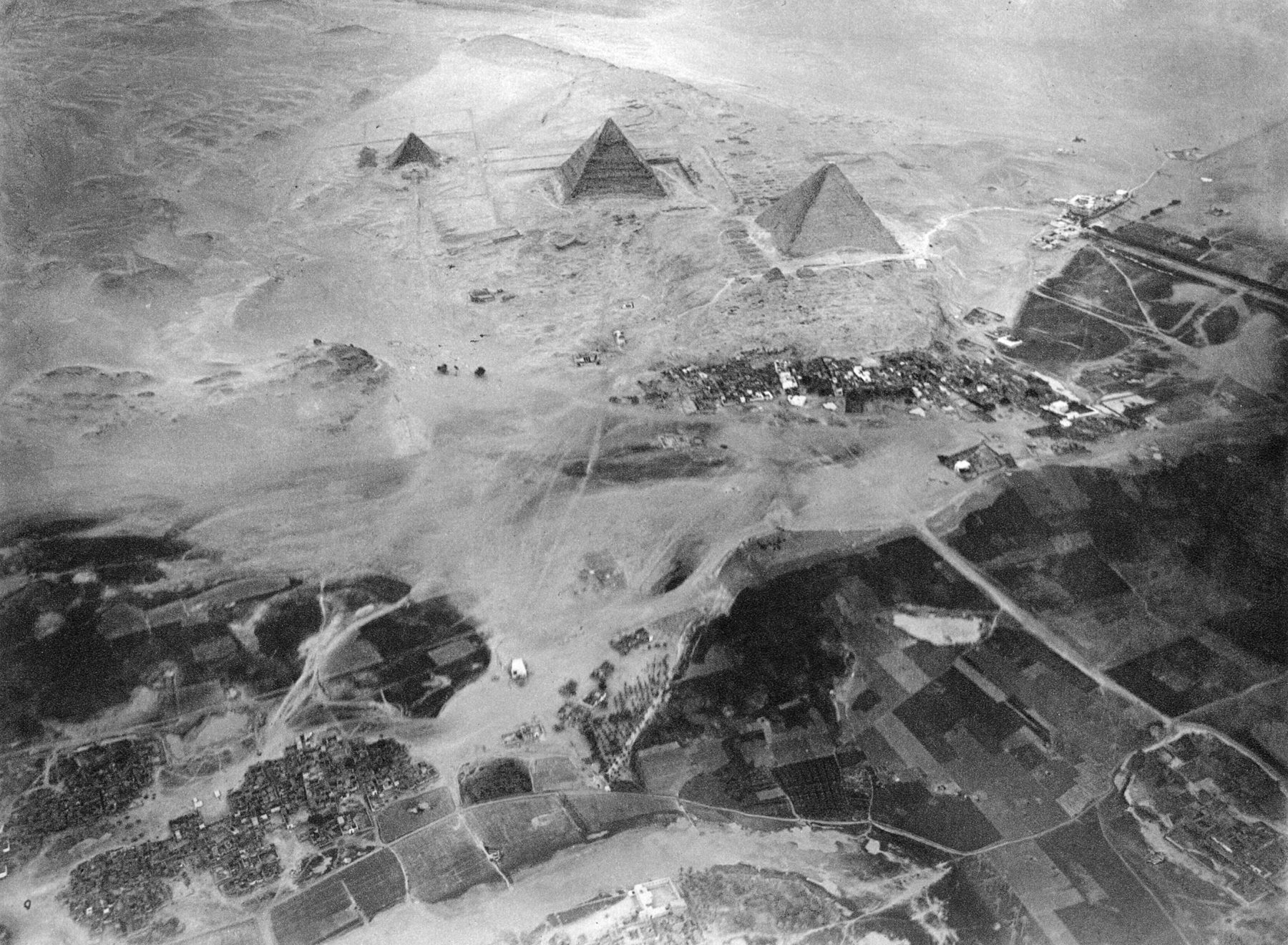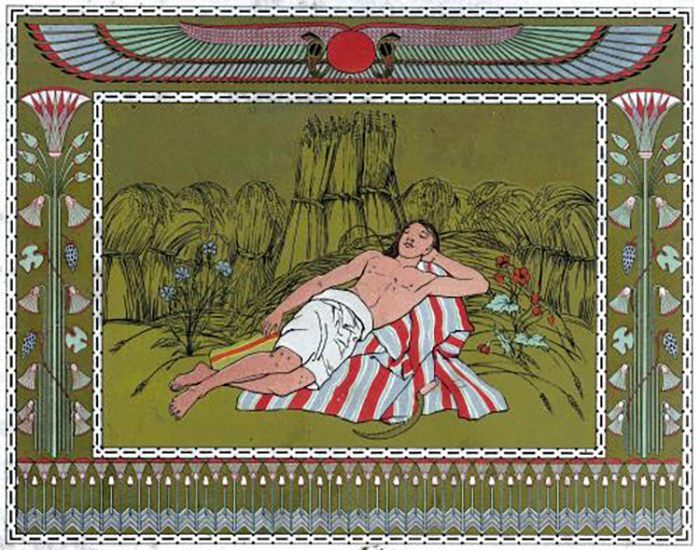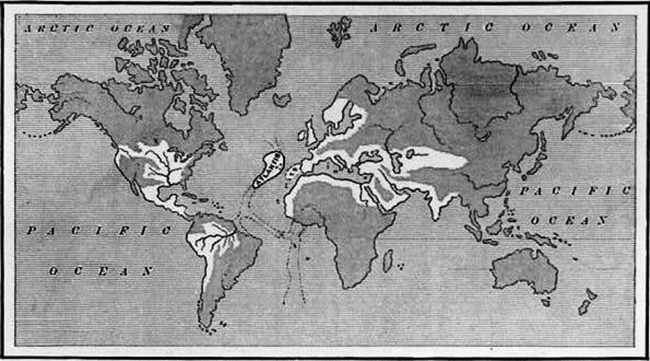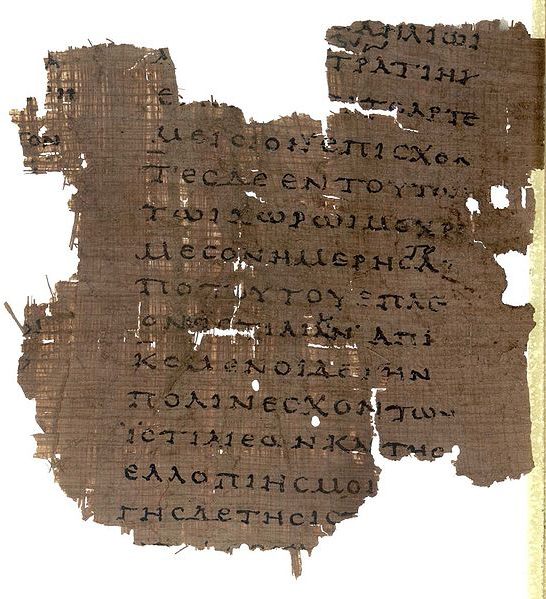Secret Chambers, Grain Silos and the Long, Long History of Pyramid Conspiracy Theories

The Giza Pyramid complex, photographed by Eduard Spelterini from a hot air balloon in 1904. (Photo: Public Domain/WikiCommons)
In 867 AD, a European monk named Bernard caught a ride on a slave ship out of the southern Italian city of Taranto. He was heading for the Holy Land, on a pilgrimage with two fellow monks. Somewhere along the line, though, they decided to make a detour through Egypt. This was a pretty normal travel itinerary for the time. In fact, in his book, Wonderful Things: A History of Egyptology from Antiquity to 1881, author Jason Thompson writes that even many of the Crusades for the Holy Land ended up sacking Egypt, instead. And that fact might go a long way toward explaining why Bernard and his friends were promptly dumped into a Cairo prison and had to bribe their way back out.
From this rather inauspicious tour guide comes what is likely the first first-person account of the Pyramids of Giza in Western literature.
Bernard, echoing older traditional stories told by people who hadn’t seen the pyramids first-hand, calls them “Joseph’s granaries”. He’s name-dropping a hero of the Biblical book of Genesis, a son of Jacob who is sold into slavery by his brothers and then rises to political power as an advisor to the Egyptian pharaoh. (You probably know him best as the owner of the amazing Technicolor dreamcoat.) In one story, Joseph saves Egypt by predicting a famine and convincing the pharaoh to store up seven years worth of grain in advance.

Illustration of Joseph with his grain (and coat)), from the 1869 book The History of Joseph and His Brethren. (Photo: Public Domain/WikiCommons)
Pyramids have been in the news recently: Thermal scans just showed the existence of “anomalies” in stones at Giza, suggesting empty spaces, warmer internal air currents or different building materials. Already, online chatter turns to speculation that it’s a secret chamber hiding god-knows-what treasures. Last week, Buzzfeed posted an old video from 1998 showing presidential candidate Ben Carson talking about how he believes, essentially, the same thing Bernard the monk believed almost 1,500 years ago. “My own personal theory is the Joseph built the pyramids to store grain,” Carson said. “Now all the archaeologists think they were made for the pharaohs’ graves. But, you know, it would have to be something awfully big if you stop and think about it. And I don’t think it’d just disappear over the course of time to store that much grain.”
Carson has presented this idea as a Biblical view of history. Bernard probably would have, as well. But, in reality, Genesis never mentions the pyramids or anything like them. Instead, Bernard and Carson are both part of a different and equally powerful Western tradition: Speculating wildly about the wonders of ancient Egypt for fun and profit.
It’s a big-tent institution, encompassing the secular and the religious, the Atlanteans and the aliens and the people who believe England is home to the lost tribes of Israel. In fact, it dates all the way back to the very “father of history” himself, Herodotus, the ancient Greek who wrote a nine-volume history of the world sometime around 450 BC. Herodotus presents his work on Egypt as first-hand information and, for a very long time—like, up until the 1950s—scholars generally took him at his word. Eventually, people started to notice that not everything Herodotus had to say made sense, says Ethan Watrall, a Michigan State University professor of anthropology, who specializes in both Egyptology and pseudoarchaeology.

Ignatius Donelly’s map of the Atlantean Empire, from his book Atlantis: the Antediluvian World, 1882. (Photo: Public Domain/WikiCommons)
For instance, Herodotus describes watching the process of mummification and says that it involved soaking a corpse in a bath of liquefied natron salt, which desiccated it. “But how could you desiccate something in liquid?” Watrall says. “It’s illogical.” Today, we know that mummies were, instead, desiccated by covering them in bags stuffed with natron—larger versions of the “DO NOT EAT” packets you might find in your dried fruit. Herodotus got the bit about natron right. But it’s also obvious that he never watched the mummification process himself.
Herodotus’ slight exaggerations pale in comparison to, say, the work of Ignatius Donnelly, the second lieutenant governor of Minnesota, 19th-century state representative, and Atlantean literalist. Donnelly gets the credit for popularizing the idea that Plato’s probably-allegorical lost city was, in fact, totally real, and also highly advanced. When Atlantis fell, Donnelly wrote, its refugees became the rulers and/or gods and goddesses of all the world’s great ancient civilizations, including Egypt. Ancient Egyptian culture came to mimic that of lost Atlantis. It was the Atlanteans who designed and built the pyramids.

Fragment from Herodotus’ Histories, Book VIII on papyrus, dated to early 2nd century AD. (Photo: Public Domain/WikiCommons)
You only have to turn on the History Channel to see how this thread stretches into our own time period—despite the fact that the actual ancient Egyptians flat-out told us both why and how the pyramids were built.
“They were prolific bureaucrats. Building it was a massive state undertaking, a public works project,” Watrall says. “The logistics and ideology are clearly documented in thousands and thousands of texts.”
So why would anyone believe in Atlanteans or think the Egyptians stored grain in pyramids? We are, after all, talking about one of the most self-documented ancient civilizations in the world. Why not listen to what they say about themselves?
According to Watrall, there are two big reasons that ancient Egypt attracts grandiose claims, evidence-free speculation, and insinuations of conspiracy. First, you have the people, like Carson, who believe that every word of the Bible is a literal history book/encyclopedia. When they look at a place like Egypt, which figures prominently in the Old Testament, they want to see evidence that their religious text really is true. And that leads them from point A to point Z—Joseph built storehouses of grain for the pharaoh, grain silos are often big buildings, pyramids are big buildings, so maybe the pyramids are grain silos.It may not be a literal interpretation of the Bible to say that Joseph stored grain in the pyramids, but the desire for Biblical literalism drives people to make those logical leaps.

Inside the Great Pyramid of Giza: The King’s Chamber, with sarcophagus. (Photo: Public Domain/WikiCommons)
The other source of Egyptian pseudoscience is more universal, but also more malignant. The pyramids, you may have noticed, are big—really, crazily, overwhelmingly massive. To stand in their shadow is to be in awe of a level of engineering and coordination that few of us can imagine successfully undertaking. And so, we choose to believe that no humans were capable of it, and definitely not people who lived a long time ago, and who were so different than us, and clearly very backward.. “And the problem with that,” Watrall says, “is that the underlying principal is, at best, highly ethnocentric and, at worst, rank racism.”
If Bernard (and Ben Carson) had taken a closer look at the region, they’d have seen extraordinary clear evidence that the pyramids are not giant grain silos. Near the Pyramids of Giza, archaeologists have uncovered Gebel Qibli, a city that basically functioned as the company town for the workers who built the pyramids. Those workers were paid in grain, collected as taxes on noble landowners, Watrall says—so Gebel Qibli is home to actual ancient Egyptian grain storage buildings. These are circular, mud-brick structures, sealed against bugs with more mud, but not so sealed that fungus could grow in the stagnant air. “I could stand in the middle of one of them, reach my arms out and that would be the diameter,” Watrall says. “I couldn’t stand up. It’s less than my height and I’m 6’5”.







Follow us on Twitter to get the latest on the world's hidden wonders.
Like us on Facebook to get the latest on the world's hidden wonders.
Follow us on Twitter Like us on Facebook